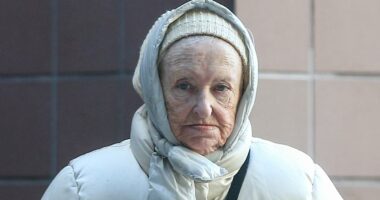Share this @internewscast.com
The widow of the first casualty in the 1986 Chernobyl nuclear disaster has tragically lost her life in a ruthless Russian assault on Kyiv, almost four decades after surviving the catastrophic event.
In a shocking overnight attack by Vladimir Putin’s military, an apartment building known for housing Chernobyl survivors was struck, resulting in the death of 62-year-old Natalia Khodemchuk.
Natalia was rescued from the debris with severe burns covering nearly half of her body. Despite being rushed to the hospital, doctors were unable to save her life.
Her husband, Valery Khodemchuk, a Soviet engineer, was the first victim of the 1986 disaster, losing his life when Reactor 4 exploded and his body was never recovered.
At the age of 35, Valery made his last phone call at 1:23 a.m., moments before the explosions devastated Unit Four’s pump halls.
Though she survived the nuclear explosion, almost 40 years later, Natalia met a violent end at the hands of Russian forces.
The same Russian strike also tore into the home of Chernobyl engineer Oleksiy Ananenko, now 66, one of the three ‘suicide divers’ who saved the world by wading through radioactive water to avert a second cataclysm.
His flat was left blackened with smoke, forcing his wife, Valentyna, 55, to drag him to safety in the dark.

The Russian attack in Ukraine overnight left Natalia Khodemchuk fatally wounded

The sickening overnight strike by Vladimir Putin ‘s forces tore through the apartment block

The block, well known to Moscow, was originally built to house workers relocated after the 1986 explosion, a community of survivors now targeted again
‘We woke up at 1:30am because we heard a drone flying,’ she said. ‘And then the explosion came immediately.
‘When I looked out the window, pieces of debris were lying on the ground, burning. I realised it was our building.
‘Then I came here into the corridor, and a neighbour was already shouting that our building was on fire. When we opened the door, very acrid smoke came in. It was impossible to breathe.
‘We left our flat and went to the neighbour on the other side. There was no smoke there, so we shut ourselves in and waited it out…. When I came back in, everything was black, filled with thick black smoke.’
The block, well known to Moscow, was originally built to house workers relocated after the 1986 explosion, a community of survivors now targeted again.
Natalia became the seventh fatality from Friday’s barrage, which also left 35 injured in what officials called one of the war’s heaviest bombardments of the capital.
Images from Kyiv show the shattered, drone-hit building where Chernobyl’s survivors were once promised safety.
British actor Kieran O’Brien portrayed Valery Khodemchuk in the Chernobyl miniseries. Ananenko, portrayed by Icelandic actor Baltasar Breki Samper in HBO’s Chernobyl, remains a national hero.
With senior engineer Valeri Bespalov and shift supervisor Boris Baranov, he volunteered to descend into radioactive water to drain the coolant system and prevent a multi-megaton steam explosion that could have rendered much of Europe uninhabitable.
‘I did my job and it’s nothing to brag about,’ he later recalled. ‘I wasn’t scared because I focused on my duties.’
He described wading through the pitch-black water, guided only by marked valves:
‘We just opened the latches and immediately there was a noise. We understood the water was gone and we just had to go back.’
Doctors said she had suffered devastating burns to her face and upper body, alongside severe heart complications, and could not be saved.
Her husband Valery’s final moments remain part of the historical record. Seconds before the reactor blew, he had called fellow operator Aleksandr Odintsov:

Natalia Khodemchuk, the widow of the the first casualty of the Chernobyl disaster Valery Khodemchuk
‘I need to recharge the lower feed for [pump number] 22… Okay, come on. So it’s shortened, one sec…’
At 1:23:48am, the reactor erupted. He died instantly.
Images from Kyiv show the shattered, drone-hit building where Chernobyl’s survivors were once promised safety.
The explosion on 26 April 1986 destroyed Reactor Number 4 at the nuclear plant in Ukraine, then, like Russia, part of the Soviet Union.
Five days later scientists discovered the core was still melting and burning through to the basement, where five million gallons of water were stored.
They feared that if 185 tons of molten nuclear lava hit the water below, it would cause a radioactive steam explosion of 3-5 megatons which would have made much of Europe uninhabitable for hundreds of thousands of years.

















